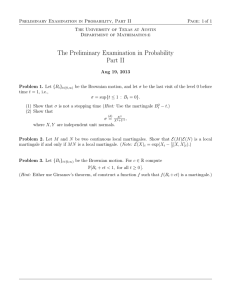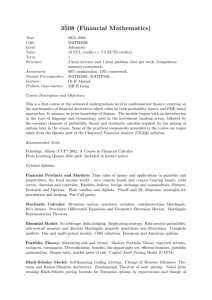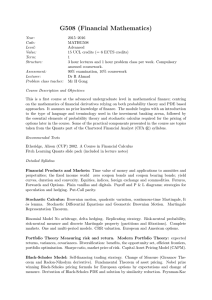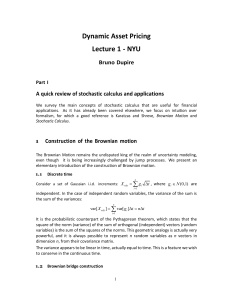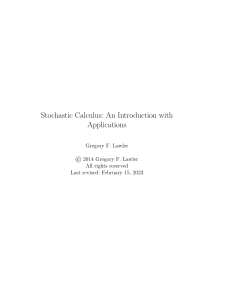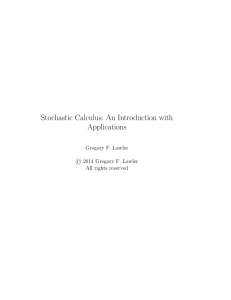Slides 3
advertisement
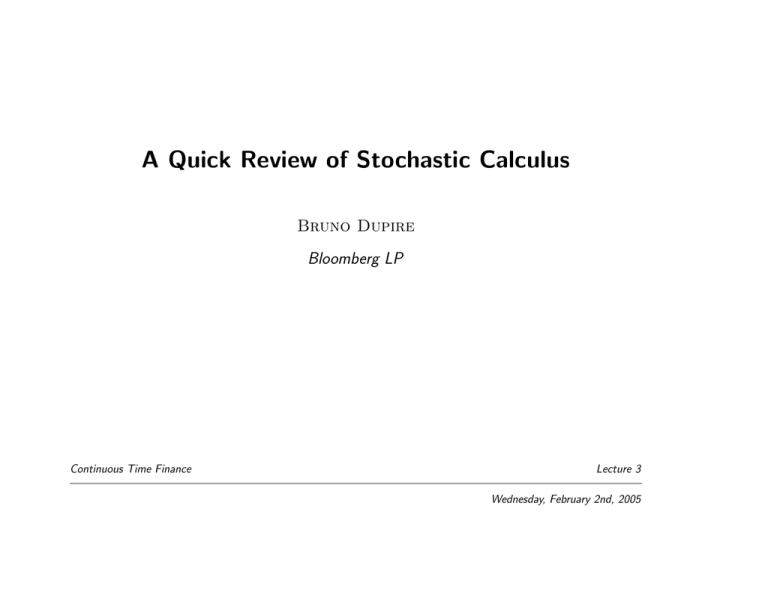
A Quick Review of Stochastic Calculus
Bruno Dupire
Bloomberg LP
Continuous Time Finance
Lecture 3
Wednesday, February 2nd, 2005
Construction of Brownian Motion
• Gaussian i.i.d. increments:
√
Pn
– Xn∆t = i=1 gi ∆t, where gi ∈ N (0, 1) are independent.
P
– var[Xn∆t] =
var[gi]∆t = n∆t
– Probabilistic version of Pythagorean Theorem
– Need to pass to continuous time, preserving variance
• Brownian Bridge:
– Iterative Construction of paths
– Refines paths without altering previous nodes
– Can be seen as fractal w/random seed
2
• Harmonic Decomposition:
– Orthonormal basis {fi} of L2[0, T ]
Rt
P
– Wt = giFi(t), where Fi(t) = 0 fi(s)ds, gi ∈ N (0, 1)
– Check that in fact E[Wt2] = t
– Can use Principal Component Analysis (PCA) to optimize L2 convergence
• Reference: Karatzas and Shreve/Brownian Motion and Stochastic Calculus
• Implementations as Monte Carlo Schemes:
– Discrete time Construction ⇒ Euler Method
– Brownian Bridge =⇒ Binary Tree
– Harmonic Decomposition =⇒ ”Shoebox”
3
Quadratic Variation
• lim∆t→0
P
(Xti+1 − Xti )2
• Brownian Motion: Central Limit Theorem tells us that QVTW = T
• Heuristic for a binomial tree to approximate Brownian Motion:
√ approximate increments by one-period binomial model going up and down by ∆t
• ”Converse to CLT” gives completeness of stock and bond
4
Ito’s Formula and the Black Scholes PDE
• The quadratic variation of dW gives the following mutliplication table:
dt dW
dt 0 0
dW 0 dt
• Can formally approximate a twice differentiable function:
1
f (X + dX) = f (X) + f 0(X)dX + f 00(X)dX 2
2
• Assuming dX = adt + bdWt, table above gives: dX 2 = b2dt
5
• Writing the coefficients in a table:
dt
dX
a
df ft + afx + 12 b2fxx
df − fxdX
ft + 21 b2fxx
dW
b
bfx
0
• continuous version of the difference equation obtained in the binomial tree:
σ2S 2
dV − VS dS = (Vt +
VSS )dt = r(V − VS S)dt
2
• No Arbitrage ⇒ Black Scholes
1
Vt + σ 2S 2VSS − r(V − VS S) = 0
2
6
Stochastic Integrals
• Consider the following strategy (assuming 0 risk free interest):
1. at
2. at
3. at
4. at
time
time
time
time
t1
t2
t3
t4
buy 20 shares at $100.
buy 10 shares at $120.
sell 20 shares at $110.
sell 10 shares at $100.
• Question: How does one calculate the P&L here?
• Answer leads to stochastic integral
•
X
Z
ati (Xti+1 − Xti ) →
7
atdXt
Martingale Representation and the FTAP
• Martingale Representation Theorem
(MRT1): X - a continuous martingale
RT
starting at 0 - can be written XT = 0 atdWt
• No Arbitrage ⇒ Equivalent Martingale Measure
• Option Vt = Et[HT ] then satisfies
Z
Vt = V0 +
t
asdWs
0
• Stock price can be written
Z
St = S0 +
σsSsdWs
0
8
t
•
Z
HT = VT = V0 +
0
9
T
at
dSt
σtSt
Change of Measure
• Radon Nikodym Derivative:
– Assume P ∼ Q
– The R-N Derivative is then
•
dQ
dP
Z
EQ[X] =
Z
X(ω)dQ(ω) =
Ω
X(ω)
Ω
dQ
dQ
(ω)dP(ω) = EP[X
]
dP
dP
• Girsanov’s Theorem:
– W is Brownian Motion under P
– Under Q there is a drift α, so EQ[dW ] = αdt
–
<α>
dQ
= eαdW − 2
dP
10
• In the other direction: (drift from measure change)
–
–
dS
= µdt + σdW P
S
dS
= νdt + σdW Q
S
–
EQ[W P] = (
ν−µ
)t
σ
–
WQ = WP + (
11
µ−ν
)t
σ
Change of Numeraire
•
EQ[S · X] = S0EQS [X] = X0EQX [S]
• QS , QX are chosen to make the respective variables constant.
• Example: price of a call option
C = E[(S−K)+] = E[(S−K)·X] = S0EQS [X]−KE[X] = S0QS [S > K]−KQ[S > K].
• Asset A risk neutral measure QA
• XA(0) = EQA [XA(T )] - subscript indicates units of A, the numeraire.
12
• To change to $ ’s:
X(0)
X(T )
= EQA [
]
A(0)
A(T )
• Common choice of numeraire: money market account β
Qβ
R
− 0T rs ds
X(0) = E [X(T )e
13
] = B(0, T )EQβ [X(T )]
Application of Change of Numeraire: HJM
• The instantaneous forward rate:
ft,T = lim∆T →0
Bt,T − Bt,T +∆T
Bt,T
• Change measure from the martingale measure QT to Qβ
•
EQB [dW QT ] = σB dt
•
Z
σB =
T
σt,sds
t
14
•
Z
T
σt,sdsdt + σt,T dW Qβ
dft,T = σt,T
0
15


